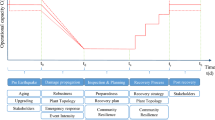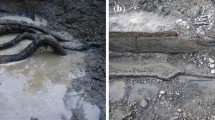Abstract
Industrial facilities, as an essential part of socio-economic systems, are susceptible to disruptions caused by earthquakes. Such disruptions may result from direct structural damage to facilities or their loss of functionality due to impacts on their support facilities and infrastructure systems. Decisions to improve the seismic performance of industrial facilities should ideally be informed by risk (and resilience) analysis, taking into account their loss of functionality and the following recovery under the influence of various sources of uncertainty. Rather than targeting specific individual facilities like a hazardous chemical plant, our objective is to quantify the resilience of interacting industrial facilities (i.e., networked industrial facilities) in the face of uncertain seismic events while accounting for their functional dependencies on infrastructure systems. A specific facility, such as a hazardous chemical plant, can be a compound node in the network representation, interacting with other facilities and their supporting infrastructure components. In this context, a compound node is a complex system in its own right. To this end, this paper proposes a formulation to model the functionality of interacting industrial facilities and infrastructure using a system of coupled differential equations, representing dynamic processes on interdependent networked systems. The equations are subject to uncertain initial conditions and have uncertain coefficients, capturing the effects of uncertainties in earthquake intensity measures, structural damage, and post-disaster recovery process. The paper presents a computationally tractable approach to quantify and propagate various sources of uncertainty through the formulated equations. It also discusses the recovery of damaged industrial facilities and infrastructure components under resource and implementation constraints. The effects of changes in structural properties and networks’ connectivity are incorporated into the governing equations to model networks’ functionality recovery and quantify their resilience. The paper illustrates the proposed approach for the seismic resilience analysis of a hypothetical but realistic shipping company in the city of Memphis in Tennessee, United States. The example models the effects of dependent water and power infrastructure systems on the functionality disruption and recovery of networked industrial facilities subject to seismic hazards.




Similar content being viewed by others
Data availability
The datasets analysed during the current study are available from the corresponding author on reasonable request.
References
Ang AH-S, Tang WH (2007) Probability concepts in engineering planning and design: emphasis on applications in cvil & environmental engineering. Wiley, New York, NY
Ballantyne DB, Berg E, Kennedy J, Reneau R, Wu D (1990) Earthquake loss estimation modeling of the seattle water system. Technical report, Kennedy/Jenks/Chilton, Federal Way, WA
Bishop C (2006) Pattern recognition and machine learning. Springer-Verlag, New York, NY
Bressan A, Čanić S, Garavello M, Herty M, Piccoli B (2014) Flows on networks: recent results and perspectives. EMS Surv Math Sci 1(1):47–111
Brown T, Hörsch J, Schlachtberger D (2017) PyPSA: python for power system analysis. J Open Res Softw. https://doi.org/10.48550/arXiv.1707.09913
Brunton SL, Proctor JL, Kutz JN (2016) Discovering governing equations from data by sparse identification of nonlinear dynamical systems. In: Proceedings of the National Academy of Sciences 113(15):3932–3937
BSSC (2015). Nehrp recommended seismic provisions for new buildings and other structures, volume 1: Part 1 provisions, part 2 commentary. Technical report, FEMA P-1050-1, Washington, DC, USA
Caputo, A. C, Giannini, R, and Paolacci, F. (2015). Quantitative seismic risk assessment of process plants: state of the art review and directions for future research. In: ASME 2015 pressure vessels and piping conference, Boston, Massachusetts, USA. American Society of Mechanical Engineers
Caputo AC, Paolacci F, Bursi OS, Giannini R (2019) Problems and perspectives in seismic quantitative risk analysis of chemical process plants. J Press Vessel Technol 141(1):010901
Christou V, Bocchini P, Miranda MJ, Karamlou A (2018) Effective sampling of spatially correlated intensity maps using hazard quantization: application to seismic events. ASCE-ASME J Risk Uncertain Eng Syst, Part A: Civil Eng 4(1):04017035
Eidinger J, Avila E, Ballantyne D, Cheng L, Der Kiureghian A, Maison B, O’Rourke T, Power M (2001) Seismic fragility formulations for water systems, part 1: Guideline. Technical report, American Lifelines Alliance, Reston, VA, USA
El-Halwagi MM, Sengupta D, Pistikopoulos EN, Sammons J, Eljack F, Kazi M-K (2020) Disaster-resilient design of manufacturing facilities through process integration: principal strategies, perspectives, and research challenges. Front Sustain 1:595961
Ellingwood BR, Wang N, Harris JR, McAllister TP (2019) Performance-based engineering to achieve community resilience. In: Gardoni P (ed) Handbook of sustainable and resilient infrastructure. Routledge, pp 94–112
FEMA (2014). Multi-hazard loss estimation methodology: earthquake model HAZUS-MH 2.1 technical manual. Technical report, Federal Emergency Management Agency, Washington, DC
Gardoni PE (2017) Risk and reliability analysis: theory and applications. Springer, Berlin
Gardoni PE (2019) Routledge handbook of sustainable and resilient infrastructure. Routledge
Gardoni P, Der Kiureghian A, Mosalam K (2002) Probabilistic capacity models and fragility estimates for reinforced concrete columns based on experimental observations. J Eng Mech 128(10):1024–1038
Grigoriu M (2009) Reduced order models for random functions. application to stochastic problems. Appl Math Model 33(1):161–175
Guckenheimer J, Holmes P (2013) Nonlinear oscillations, dynamical systems, and bifurcations of vector fields. Springer, Berlin
Hwang HH, Lin H, Shinozuka M (1998) Seismic performance assessment of water delivery systems. J Infrastruct Syst 4(3):118–125
Iannacone L, Gardoni P (2022) Physics-based repair rate curves for segmented pipelines subject to seismic excitations. Sustain Resil Infrastruct. https://doi.org/10.1080/23789689.2021.2000146
Iannacone L, Sharma N, Tabandeh A, Gardoni P (2022) Modeling time-varying reliability and resilience of deteriorating infrastructure. Reliab Eng Syst Saf 217:108074
Jia G, Gardoni P (2018) State-dependent stochastic models: a general stochastic framework for modeling deteriorating engineering systems considering multiple deterioration processes and their interactions. Struct Saf 72:99–110
Klise, K. A, Hart, D, Moriarty, D, Bynum, M. L, Murray, R, Burkhardt, J, and Haxton, T. (2017). Water network tool for resilience (WNTR) user manual. Technical Report SAND2017–8883R, Sandia National Laboratories (SNL-NM), Albuquerque, NM, USA
Kongar I, Giovinazzi S, Rossetto T (2017) Seismic performance of buried electrical cables: evidence-based repair rates and fragility functions. Bull Earthq Eng 15:3151–3181
Krausmann E, Girgin S, Necci A (2019) Natural hazard impacts on industry and critical infrastructure: Natech risk drivers and risk management performance indicators. Int J Disaster Risk Reduct 40:101163
Kumasaki M, King M (2020) Three cases in Japan occurred by natural hazards and lessons for Natech disaster management. Int J Disaster Risk Reduct 51:101855
Lee R, Kiremidjian AS (2007) Uncertainty and correlation for loss assessment of spatially distributed systems. Earthq Spectra 23(4):753–770
Miller M, Baker JW (2015) Ground-motion intensity and damage map selection for probabilistic infrastructure network risk assessment using optimization. Earthqe Eng Struct Dyn 44(7):1139–1156
Newman M (2018) Networks. Oxford University Press, Oxford
Petersen MD, Moschetti MP, Powers PM, Mueller CS, Haller KM, Frankel AD, Zeng Y, Rezaeian S, Harmsen SC, Boyd OS, Field N, Chen R, Rukstales KS, Luco N, Wheeler RL, Williams RA, Olsen AH (2014). Documentation for the 2014 update of the United States national seismic hazard maps. Technical report, US Geological Survey Open-File Report 2014-1091
Phan HN, Paolacci F, Di Filippo R, Bursi OS (2020) Seismic vulnerability of above-ground storage tanks with unanchored support conditions for Na-tech risks based on Gaussian process regression. Bull Earthq Eng 18:6883–6906
Means RS (2016) Building construction costs book. Construction publishers and consultants, Kingston, MA
Sharma, N, Tabandeh A, Gardoni P (2019). Resilience-informed recovery optimization: a multi-scale formulation for interdependent infrastructure. Computer-aided civil and infrastructure engineering, (in preparation)
Sharma N, Gardoni P (2022) Mathematical modeling of interdependent infrastructure: an object-oriented approach for generalized network-system analysis. Reliab Eng Syst Saf 217:108042
Sharma N, Tabandeh A, Gardoni P (2020) Regional resilience analysis: a multiscale approach to optimize the resilience of interdependent infrastructure. Comput-Aided Civil Infrastruct Eng 35(12):1315–1330
Sharma N, Gardoni P (2019a). Mathematical modeling of interdependent infrastructure: an object-oriented approach for generalized network-system analysis. Reliability Engineering & System Safety. page (submitted)
Sharma N, Gardoni P(2019b). Promoting resilient interdependent infrastructure: the role of strategic recovery scheduling. Computer-aided civil and infrastructure engineering, (in preparation)
Steelman J, Hajjar JF (2008). Capstone scenario applications of consequence-based risk management for the memphis testbed. Technical report, University of Illinois Urbana-Champaign, Urbana, IL
Sun W, Bocchini P, Davison BD (2022) Overview of interdependency models of critical infrastructure for resilience assessment. Nat Hazard Rev 23(1):04021058
Tabandeh A, Sharma N, Gardoni P (2022) Uncertainty propagation in risk and resilience analysis of hierarchical systems. Reliab Eng Syst Saf 219:108208
Thompson EM, Wald DJ, Worden B, Field N, Luco N, Petersen MD, Powers PM, Badie R (2016) Shakemap earthquake scenario: building seismic safety council 2014 event set (BSSC2014). Technical report, US Geological Survey Digital Object Identifier Catalog
Vanmarcke E (2010) Random fields: analysis and synthesis. World Scientific, Singapore
Wagner JM, Shamir U, Marks DH (1988) Water distribution reliability: simulation methods. J Water Resour Plan Manag 114(3):276–294
Xu H, Gardoni P (2020) Multi-level, multi-variate, non-stationary, random field modeling and fragility analysis of engineering systems. Struct Saf 87:101999
Funding
The research presented in this paper was supported in part by the Center for Risk-Based Community Resilience Planning funded by the U.S. National Institute of Standards and Technology (NIST Financial Assistance Award Number: 70NANB15H044). The views expressed are those of the authors and may not represent the official position of the sponsor.
Author information
Authors and Affiliations
Corresponding author
Ethics declarations
Conflict of interest
The authors have no financial interest.
Additional information
Publisher's Note
Springer Nature remains neutral with regard to jurisdictional claims in published maps and institutional affiliations.
Rights and permissions
Springer Nature or its licensor (e.g. a society or other partner) holds exclusive rights to this article under a publishing agreement with the author(s) or other rightsholder(s); author self-archiving of the accepted manuscript version of this article is solely governed by the terms of such publishing agreement and applicable law.
About this article
Cite this article
Tabandeh, A., Sharma, N. & Gardoni, P. Seismic risk and resilience analysis of networked industrial facilities. Bull Earthquake Eng 22, 255–276 (2024). https://doi.org/10.1007/s10518-023-01728-5
Received:
Accepted:
Published:
Issue Date:
DOI: https://doi.org/10.1007/s10518-023-01728-5




